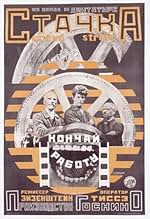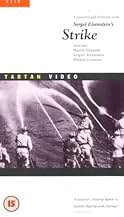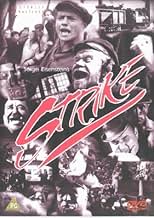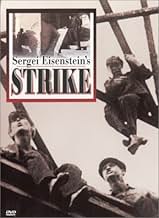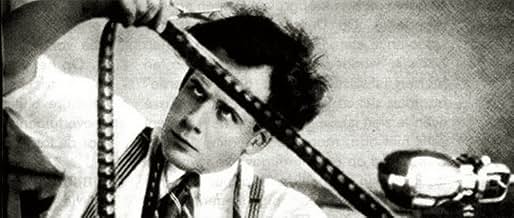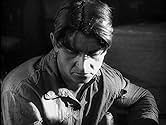VALUTAZIONE IMDb
7,6/10
8902
LA TUA VALUTAZIONE
Un gruppo di operai di fabbrica oppressi sciopera nella Russia prima della rivoluzione.Un gruppo di operai di fabbrica oppressi sciopera nella Russia prima della rivoluzione.Un gruppo di operai di fabbrica oppressi sciopera nella Russia prima della rivoluzione.
Leonid Alekseev
- Factory Sleuth
- (non citato nei titoli originali)
Daniil Antonovich
- Worker
- (non citato nei titoli originali)
Pyotr Malek
- Police Spy
- (non citato nei titoli originali)
Misha Mamin
- Baby Boy
- (non citato nei titoli originali)
Pavel Poltoratskiy
- Stockholder
- (non citato nei titoli originali)
Trama
Lo sapevi?
- QuizStrike (Russian: Sciopero (1925)) is a Soviet silent propaganda film edited and directed by Sergei Eisenstein. Originating as one entry out of a proposed seven-part series titled "Towards Dictatorship of the Proletariat," Strike was a joint collaboration between the Proletcult Theatre and the film studio Goskino. As Eisenstein's first full-length feature film, it marked his transition from theatre to cinema, and his next film La corazzata Potemkin (1925) (Russian: Bronenosets Potyomkin) emerged from the same film cycle.
- BlooperThe story is set in 1903. Throughout the film, automobiles from the 1920s appear on streets. One is the 1920s auto that the worker (who stole the administrators' posted reply to workers' demands) tried to use to escape police goons during a nighttime rainstorm. When upper-class women appear, they are wearing contemporary 1920s fashions, and the popular music that's on the sound track is also from the 1920s.
- Citazioni
Title Card: At the factory, all is calm. BUT. The boys are restless.
- Versioni alternativeThe film was restored at Gorky Film Studio in 1969.
- ConnessioniEdited into Ten Days That Shook the World (1967)
Recensione in evidenza
More so with the Soviets than with any other film school, we need to resupply the context. The image reigns supreme but not in ways we may understand today, as aesthetic accomplishment or space for contemplation. It is about immediate understanding as formed in the eye so that narrative - the tool by which the Czarist or the bourgeois wrote history, thus a suspicious element - is bypassed, the eye and not the mind is thus tasked to construct. Meant to instruct ideological fervor in a generally unsophisticated audience, these films, propaganda we call them now, stirred into action, not thought. This was in tacit understanding with Marxist principles, that demanded history be foremostly changed than understood.
Change; action; seeing. This is the causal chain the Soviets immersed themselves in, looking for the keys that guide vision.
So, these people eventually grew to know more about the mechanisms that control the image than any other group of people anywhere else in history. They were theoreticians, scientists of film, as well as the actual makers; a now extinct combination, much to our dismay. Eisenstein - and Vertov - were key figures; I mean, here was a man who studied Japanese ideograms to understand synthesized image; who discovered that editing to the beats of the human heart affected more.
So, we are talking about a reflexive cinema, about rhythm as opposed to melody. It's just as well with these films that the narrative content is pretty much discarded by now, even though the agitprop often agitated in the right direction; or have we forgotten that workers, at some point, were truly horribly exploited and that the 8-hour workshift was a bloody struggle? But, being able to quickly sift through caricatures - the fat, capitalist factory owner, the well-groomed, pigheaded stockholders slobbering on their fat cigars - and process the easy distinctions between collective good and the individual selfishness, means we can concentrate on rhythm. On how these thin caricatures that should have been harmless, yet are charged with a power that moves and affects.
It's about the mechanisms that control the image; it is a unique opportunity to have this film, it shows the very image being controlled. The end of the first part, with the shot of huge factory machinery whirring into motion as already the uprising is being set into motion; and later, the hand of the cruel stockholder superimposed over the crowd of strikers, clutching, controlling.
Eisenstein is so adept in his touch that the film is, at times, action, comedy, chamber drama, detective film, policier, paean, sobering catastrophe.
The most amazing sequence; we are with the strikers in an outdoors gathering, as the leader is laying down their demands, yet immediately transported to the lavish mansion of the stockholders as they read them with anger; there is some talk and eventually, satisfied, gleeful, they break out the drinks, an intertitle informs us of their answer to the demands, a polite, civilized refusal 'after careful consideration', while immediately the mounted police is storming the outdoors camp.
It is a stunning display of cinema, how time and space are contorted to accommodate for our passage through and yet the result is a dialectic between images as eminently designed for the eye - not the mind. We see, ergo we know - and are.
Change; action; seeing. This is the causal chain the Soviets immersed themselves in, looking for the keys that guide vision.
So, these people eventually grew to know more about the mechanisms that control the image than any other group of people anywhere else in history. They were theoreticians, scientists of film, as well as the actual makers; a now extinct combination, much to our dismay. Eisenstein - and Vertov - were key figures; I mean, here was a man who studied Japanese ideograms to understand synthesized image; who discovered that editing to the beats of the human heart affected more.
So, we are talking about a reflexive cinema, about rhythm as opposed to melody. It's just as well with these films that the narrative content is pretty much discarded by now, even though the agitprop often agitated in the right direction; or have we forgotten that workers, at some point, were truly horribly exploited and that the 8-hour workshift was a bloody struggle? But, being able to quickly sift through caricatures - the fat, capitalist factory owner, the well-groomed, pigheaded stockholders slobbering on their fat cigars - and process the easy distinctions between collective good and the individual selfishness, means we can concentrate on rhythm. On how these thin caricatures that should have been harmless, yet are charged with a power that moves and affects.
It's about the mechanisms that control the image; it is a unique opportunity to have this film, it shows the very image being controlled. The end of the first part, with the shot of huge factory machinery whirring into motion as already the uprising is being set into motion; and later, the hand of the cruel stockholder superimposed over the crowd of strikers, clutching, controlling.
Eisenstein is so adept in his touch that the film is, at times, action, comedy, chamber drama, detective film, policier, paean, sobering catastrophe.
The most amazing sequence; we are with the strikers in an outdoors gathering, as the leader is laying down their demands, yet immediately transported to the lavish mansion of the stockholders as they read them with anger; there is some talk and eventually, satisfied, gleeful, they break out the drinks, an intertitle informs us of their answer to the demands, a polite, civilized refusal 'after careful consideration', while immediately the mounted police is storming the outdoors camp.
It is a stunning display of cinema, how time and space are contorted to accommodate for our passage through and yet the result is a dialectic between images as eminently designed for the eye - not the mind. We see, ergo we know - and are.
- chaos-rampant
- 21 ago 2011
- Permalink
I più visti
Accedi per valutare e creare un elenco di titoli salvati per ottenere consigli personalizzati
- How long is Strike?Powered by Alexa
Dettagli
- Tempo di esecuzione1 ora 22 minuti
- Colore
- Mix di suoni
- Proporzioni
- 1.33 : 1
Contribuisci a questa pagina
Suggerisci una modifica o aggiungi i contenuti mancanti



